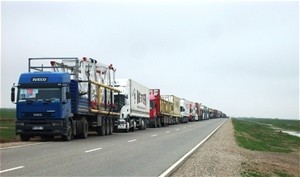
A convoy of 36 trucks loaded with 550 tons of drilling equipment travelled 3,000 km to reach Shibirghan gas fields.
USAID/IRP Steve Pearce
Gas fields hold potentially significant reserves of clean-burning fuel.
4 APRIL 2009 | SHIBIRGHAN, AFGHANISTAN
Afghanistan’s energy needs vastly outweigh its domestic production. Today, only 10-12% of Afghan citizens have access to electricity on a regular basis, and the country needs an influx of energy resources and infrastructure to provide reliable power throughout the country.
To fuel development efforts, USAID has launched a number of initiatives to increase energy output, such as rebuilding dams and power plants and importing electricity from neighboring countries. Afghanistan also possesses another prospective power source – the Shibirghan gas fields.
The Shibirghan gas fields hold potentially significant reserves of clean-burning natural gas, but years of war and lack of resources have prevented continued exploration and development. In cooperation with the Afghan Ministry of Mines, USAID recently launched an initiative to test the fields’ wells to determine whether they contain enough gas to fuel a 100-megawatt electrical power plant and a fertilizer production plant.
The power plant would benefit Afghans greatly through the clean power generated, as natural gas produces fewer pollutants than Afghanistan’s other fuels of choice – coal and diesel. Additionally, the construction and operation of both plants would create many new jobs, directly and indirectly. The plants themselves would offer a number of employment opportunities to local workers, and the increased access to electricity would enable more businesses and factories in the region to open and expand.
The first step towards this brighter future was achieved in March 2009. A 36-truck convoy drove over 3,000 km from Anatolia, Turkey to bring necessary drilling equipment to the gas fields in the northern province of Jawzjan. The trucks carried 550 tons of machinery, which will be used to test the viability of Afghanistan’s natural gas to produce electricity at the proposed power plant. While the journey was logistically daunting, the arrival of the machinery signals progress in the effort to provide more electricity to Afghanistan’s people.







Comment
Make a general inquiry or suggest an improvement.